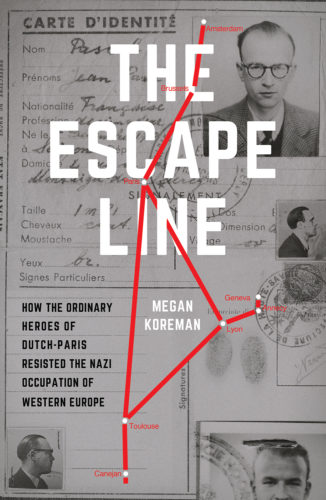Searching for the Dutch-Paris Escape Line
Qualities of a Resistance Leader – Decisiveness
We’ve been talking about the essential qualities of a resistance leader. Let’s look at another one today: decisiveness.
A gentleman who worked for Dutch-Paris as a young man once told me that he sometimes missed how simple making a plan had been during the war. As a resister he was told to meet someone at a particular place and time. He showed up. The other resister, often one of the line’s leaders, showed up. He reported how many fugitives he wanted to bring over the border from the Netherlands to Belgium and when he could be ready. The leader gave him instructions from what they’d discussed at their last meeting and told him when and where they would meet again. That was it, no back and forth or changing of plans.
Of course there was a bit of nostalgia coloring that image. The reason they had to make their plans in that way is that they could not Read the rest of this entry »
Qualities of a Resistance Leader – Social Skills
Here’s another essential quality for Here’s another essential quality for a resistance leader: the ability to get along with all sorts of people.
This was especially important for leaders of escape lines such as Dutch-Paris. They needed excellent social skills both to recruit help and to survive unexpected situations.
Escorting a fugitive of any sort, whether an American aviator or a Jewish grandmother, required a lot of help from a lot of people, including strangers. The guides essentially needed every person they came into contact with to like and trust them enough to not call the police to report suspicious activity. Even more than that they might need to find a café for fugitives to stay in for a few hours while waiting for a delayed train or a conductor to overlook an irregularity in Read the rest of this entry »
The New Guide from Les Cruseilles
Here’s another story of how a leader of Dutch-Paris recruited someone the line needed for their skills or resources based on his own judgment of the person’s character rather than by referral.
Even though Dutch-Paris counts as a very large resistance network with its 320+ members spread across western Europe, the line never had enough help. There were just so many tasks to be done in so many places. Inevitably many members of the line ended up doing the work of more than one person. But even the most energetic and willing person in Brussels cannot hide a fugitive in southern France.
Dutch-Paris was often short of manpower on the Franco-Swiss border because there were so many Read the rest of this entry »
The Problem of Being Asked
We’ve been talking about how Dutch-Paris recruited new members. No matter who a resister approached, the invitation to join the network was fraught with peril. There was the possibility that the person they were talking to was either working for the Germans or being watched by them. There was always the possibility that even someone you’d known for years might betray you. They might have even done so extremely reluctantly but under some pressure applied by the occupation authorities, such as holding a family member hostage.
Let’s pause for a moment and look at this from the other side, from the perspective of the person being asked to do something illegal and very obviously dangerous. Many people refused to help without betraying the person who asked them. Others were eager to have an opportunity to act against the oppressor or to help the persecuted.
It’s also possible that the person being asked was already in the resistance and was alarmed to be approached by strangers. The first thought had to be that these strangers claiming to be resisters could very easily be Read the rest of this entry »
Recruiting for Dutch-Paris with an Eye for Resources
We’ve been talking about how resisters often relied on the people they already knew from work or the neighborhood or their families or school to expand their networks. That makes sense because telling someone that you were involved in the illegal work of resistance was tantamount to giving them the power to destroy you by betraying you to the occupation authorities.
But Dutch-Paris did not rely solely on referrals to recruit members. As an escape line, Dutch-Paris needed some very particular things to hide fugitives and get them over international borders. Sometimes they had to trust a stranger because that stranger had access to something they needed.
For example, when John Weidner was setting up a base in Annecy, near but not on the Swiss border, he needed to be able to Read the rest of this entry »
International Companies in the Background of Dutch-Paris
In another example of employment related connections among resisters, I’ve noticed that a number of people in Dutch-Paris worked for the same Dutch insurance company, De Utrecht. If we were talking about any other circumstance than the illegal resistance during the Nazi occupation, the number would be insignificant. But these men lived in different cities, even different countries at a time when travel and communications were restricted. They were not the leaders of Dutch-Paris who circulated from place to place. They stayed in their own cities and yet managed to end up in the same highly secret resistance network.
How to explain that? Pure coincidence is always a possibility but I don’t think so. It’s entirely likely that these men knew each other, at least professionally, from their work. They may even have met at company gatherings.
And think about the advantages of working at an international insurance company would offer Read the rest of this entry »
Professional Connections within Dutch-Paris
Here’s another example of social connections among members of Dutch-Paris that were established before the war. Sometimes people recruited others for their resistance network from among the people they worked with.
There was a man in eastern Belgium, for example, who worked for a government bureau that allowed him to travel from place to place in the fulfillment of his professional duties. This was true for police officers, doctors and clergy, of course. But it was also true for people who did things like inspect and repair roads and bridges. After all, the occupation lasted five years and it was in the best interests of the occupation forces to Read the rest of this entry »
Social Connections Behind the Network
We’ve been discussing the practical consequences for resistance networks like Dutch-Paris of the fact that they could not openly recruit or advertise for the best candidates without being arrested and worse. One of these consequences was that everything they did went by word of mouth or gut instinct, meaning that many people came into contact with Dutch-Paris by referral.
As a researcher it’s very hard to trace the pathways made by such referrals because the documents don’t discuss them. Official reports or forms didn’t require a resister to explain how they came to be part of their network. They tended to ask about actions. Most of the interview type documents didn’t ask the question either. But there were definitely circles of connections outside of resistance among the men and women in Dutch-Paris. Some I uncovered. Some I can guess at. And I’m confident there are others I have no idea of.
Here’s an example. There were a number of Dutch Read the rest of this entry »
Fugitive Connections
We’ve been talking about how resistance lines, especially escape lines, were vulnerable because they had to trust strangers and were always in need of more help and more resources. Resisters knew this. They knew that they literally put their lives in someone else’s hands when they trusted them with their identity. But in a clandestine organization their only choice was to trust their guts about the character of strangers or to rely on referrals from people they did know.
The leaders of Dutch-Paris happened to be remarkably good judges of other people’s characters. They had serious doubts about some of the men who were later revealed to be working for the Germans and refused to work with them. They created very good security measures and followed them. But they had a problem unique to rescue organizations. Dutch-Paris existed to help the persecuted. Not just the persecuted whom they personally knew but the persecuted of any nation or faith.
As a clandestine organization they had to rely on the persecuted to Read the rest of this entry »
The Abwehr Officer
We’ve been talking about how resistance networks’ inability to vet recruits and those they helped made them vulnerable. Their constant need for more help and more resources also made them vulnerable, if only because it might force them to trust someone they were not 100% sure about. This combination made resisters vulnerable to German agents, some of whom were local people in the pay of the occupation authorities and some of whom were officers of German police authorities.
The German military police, the Abwehr, took great interest in Allied activity in occupied areas including the whereabouts and evasion of downed Allied aviators. They knew that there were civilians helping such aviators to evade capture and were determined to stop it. That’s why the life expectancy of an escape line was measured in months, and not many of them.
One of these Abwehr officers hired locals to infiltrate resistance networks but also went into the field himself under the name of Eugene. He relied on his employees to make the first contact with resisters and then introduce him as another resister with access to radio contact to London and false documents.
This is how it worked in the case of Dutch-Paris. One of the line’s couriers went Read the rest of this entry »

